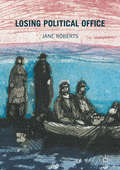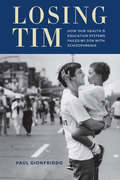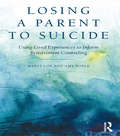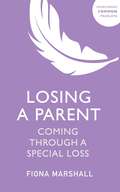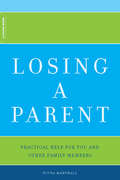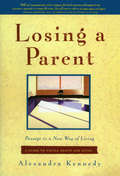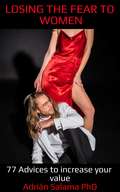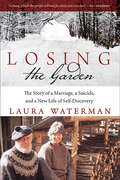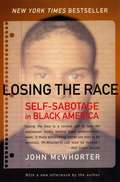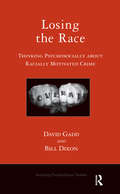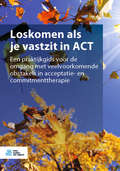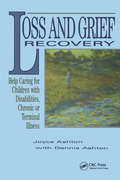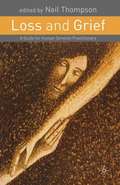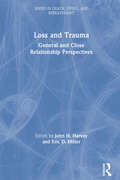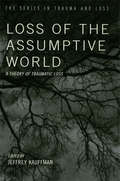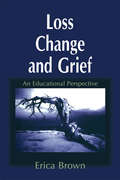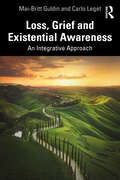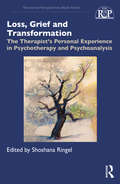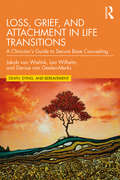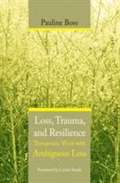- Table View
- List View
Losing Political Office
by Jane RobertsBased on in-depth interviews conducted with British politicians, this book analyses the different impacts of leaving political office. Representative democracy depends on politicians exiting office, and yet while there is considerable interest in who stands for and gains office, there is curiously little discussed about this process. Jane Roberts seeks to address this gap by asking: What is the experience like? What happens to politicians as they make the transition from office? What is the impact on their partners and family? Does it matter to anyone other than those immediately affected? Are there any wider implications for our democratic system? This book will appeal to academics in the fields of leadership, political science, public management and administration and psychology. It will also be of interest to elected politicians in central, devolved and local government (current and former), policy makers and political commentators, and more widely, the interested general reader.
Losing Tim: How Our Health and Education Systems Failed My Son with Schizophrenia
by Paul GionfriddoPaul Gionfriddo's son Tim is one of the "6 percent"—an American with serious mental illness. He is also one of the half million homeless people with serious mental illnesses in desperate need of help yet underserved or ignored by our health and social-service systems.In this moving, detailed, clear-eyed exposé, Gionfriddo describes how Tim and others like him come to live on the street. Gionfriddo takes stock of the numerous injustices that kept his son from realizing his potential from the time Tim first began to show symptoms of schizophrenia to the inadequate educational supports he received growing up, his isolation from family and friends, and his frequent encounters with the juvenile justice system and, later, the adult criminal-justice system and its substandard mental health care. Tim entered adulthood with limited formal education, few work skills, and a chronic, debilitating disease that took him from the streets to jails to hospitals and then back to the streets. Losing Tim shows that people with mental illness become homeless as a result not of bad choices but of bad policy. As a former state policy maker, Gionfriddo concludes with recommendations for reforming America's ailing approach to mental health.
Losing a Parent to Suicide: Using Lived Experiences to Inform Bereavement Counseling
by Marty Loy Amy BoelkThe suicide of a parent has life-long consequences; few more traumatic scenarios exist, and counselors often struggle for ways to help clients deal with its effects. Few understand the pain and life-altering effects of these tragedies better than children who have experienced the suicide of a parent. Despite this, there are few texts that incorporate and evaluate the first-person accounts of grief following a suicide while advancing a method for helping. Losing a Parent to Suicide analyzes stories of parent suicides and explores the grief and coping processes that follow, discovering the strategies, methods and modes of therapy that have empowered grieving individuals and helped them rebuild their lives.
Losing a Parent: Coming Through a Special Loss
by Fiona MarshallThe death of a parent brings a special kind of grief. When a parent dies, we lose a unique connection with our roots, our past, our identity and our childhood - and we are forced to confront our own mortality. Often the practicalities of bereavement take over, leaving us unable to focus on the complex realities of this loss, or platitudes and easy answers are proferred, distracting us from the grieving process. The work of grief, in fact, can take years and may change our view of life profoundly.Losing a Parent looks at how we may find meaning in what has happened. It covers both terminal illness and sudden death, helps you to navigate feelings of abandonment, and to understand the new family dynamics after loss. It will show you how, where and when to seek further support and offer you the reassurance you need to actually get on with your life after this difficult and painful time.
Losing a Parent: Coming Through a Special Loss
by Fiona MarshallThe death of a parent brings a special kind of grief. When a parent dies, we lose a unique connection with our roots, our past, our identity and our childhood - and we are forced to confront our own mortality. Often the practicalities of bereavement take over, leaving us unable to focus on the complex realities of this loss, or platitudes and easy answers are proferred, distracting us from the grieving process. The work of grief, in fact, can take years and may change our view of life profoundly.Losing a Parent looks at how we may find meaning in what has happened. It covers both terminal illness and sudden death, helps you to navigate feelings of abandonment, and to understand the new family dynamics after loss. It will show you how, where and when to seek further support and offer you the reassurance you need to actually get on with your life after this difficult and painful time.
Losing a Parent: Parent Practical Help for You and Other Family Members
by Fiona MarshallWhether from a sudden accident or a slow, terminal illness, the death of a parent is devastating to adults and children alike. In Losing a Parent, Fiona Marshall helps readers understand the process of coping with a parent's death, from preparing for death to recognizing the different stages of grief, from nurturing the relationship with the surviving parent to harnessing new strength to carry on with life. Wise, compassionate, and practical, Losing a Parent is an invaluable source of support for a time of overwhelming loss.
Losing a Parent: Passage to a New Way of Living
by Alexandra KennedyKennedy shares her own story of facing the loss of a parent and offers innovative strategies for healing and transformation.
Losing the Fear to Women: 77 advices to increase your value
by Adrian SalamaLosing the fear to Women 77 advices to increase your value The best advices to overcome your fear when approaching a woman Are you tired of not knowing how to talk to a girl? Do you freeze up when you approach the woman of your dreams? Here's a book that doesn't have straw in it and goes straight to the point that interests you. This is a book to stop once and for all, losing the fear that men have of approaching women. With these tips you will be able to: - Talk to any woman - Increase your self-esteem - Grow your social network - Apply from day 1 There are no excuses anymore for not being able to be with her. There are no more excuses for being alone. Start reading this book now to apply the best advice from the world's greatest seducers, from day one.
Losing the Garden: The Story of a Marriage, a Suicide, and a New Life of Self-Discovery (Excelsior Editions)
by Laura WatermanIn 1971, Laura and Guy Waterman left New York City for thirty-seven acres in Vermont, where they would live in a hand-built cabin without running water or electricity for the next thirty years. It was a life based largely in the nineteenth century, a life of hauling their own water and growing their own food, of lighting candles in the evening and heating their cabin with wood from the surrounding forest. Combined with the trail tending they did in the alpine zone of the White Mountains and the books they wrote about environmental stewardship, it made for a rewarding, healthy, and fruitful existence. But that was only part of their story. Guy's depression was another part, and his ultimate decision to take his own life on the wintry summit of Mount Lafayette—a decision he made with Laura's support—was the crux, a term climbers use to describe the hardest move on the climb. Being a climber herself, Laura had to confront the crux. This meant taking a close look at Guy's suicide and asking herself a hard question: How, or why, had she come to support the decision of the man she loved? In Losing the Garden, Laura Waterman comes to terms with her husband's long depression and the complex nature of a gifted, humorous man who was driven by obsession, self-absorption, and a strange lack of confidence. Her account of her own marriage, idyllic from the outside but riddled from within, is nonetheless a love story, a portrait of an intense and unusual marriage, and an affirmation of life after loss.
Losing the Race: Self-Sabotage in Black America
by John H. McWhorterBerkeley linguistics professor John McWhorter, born at the dawn of the post-Civil Rights era, spent years trying to make sense of this question. Now he dares to say the unsayable: racism's ugliest legacy is the disease of defeatism that has infected black America. Losing the Race explores the three main components of this cultural virus: the cults of victimology, separatism, and antiintellectualism that are making blacks their own worst enemies in the struggle for success. <p><p> More angry than Stephen Carter, more pragmatic and compassionate than Shelby Steele, more forward-looking than Stanley Crouch, McWhorter represents an original and provocative point of view. With Losing the Race, a bold new voice rises among black intellectuals.
Losing the Race: Thinking Psychosocially about Racially Motivated Crime (The\exploring Psycho-social Studies Ser.)
by David Gadd Bill DixonBased on a two-year research project funded by the Economic and Social Research Council (ESRC), this book explores why many of those involved in racially motivated crime seem to be struggling to cope with economic, cultural and emotional losses in their own lives. Drawing on in-depth biographical interviews with perpetrators of racist crimes and focus group discussions with ordinary people living in the same communities, the book explores why it is that some people, and not others, feel inclined to attack immigrants and minority ethnic groups. The relationships between ordinary racism, racial harassment and the politics of the British National Party are also explored, as are the enduring impacts of deindustrialisation, economic failure and immigration on white working class communities. The book assesses the legacy of New Labour policy on community cohesion, hate crime and respect in terms of its impact on racist attitudes and racist incidents, and explores how it is that racist attacks, including racist murders, continue to happen.
Loskomen als je vastzit in ACT: Een praktijkgids voor de omgang met veelvoorkomende obstakels in acceptatie- en commitmenttherapie
by Russ HarrisDit boek is dé onmisbare gids voor de juiste aanpak bij veelvoorkomende obstakels in acceptatie and commitmenttherapie (ACT). Loskomen als je vastzit in ACT biedt praktische strategieën met een stapsgewijze aanpak voor het overwinnen van de meest voorkomende obstakels en valkuilen van ACT. Elk hoofdstuk behandelt nieuwe methoden voor het motiveren van cliënten, het ondermijnen van moeilijk gedrag tijdens de sessies en het in gang zetten van defusie. Het overkomt alle therapeuten weleens dat ze ‘vast komen te zitten’. In dit boek onderzoekt Russ Harris het ‘vastzitten’ van zowel cliënten als therapeuten. Door middel van pragmatisme, ervaring, technieken, humor en menselijkheid reikt hij zowel de meer ervaren ACT-therapeuten als beginnelingen in ACT een aantal heldere, behulpzame lessen aan. Ook leert u hoe u cliënten in eenvoudige bewoordingen uitleg geeft over de belangrijke concepten van ACT, hoe u ook met snel afgeleide cliënten op het goede spoor blijft, en hoe u uw eigen belemmeringen bij het toepassen van ACT overwint. [aanbeveling]‘Russ Harris geniet zeer verdiend en wereldwijd de reputatie dat hij helderheid kan scheppen waar verwarring heerst en eenvoud kan brengen waar onnodige complexiteit heerst. Wanneer we ‘vastzitten’ in ons klinische werk, helpt het terugdringen van verwarring en complexiteit ons om weer een weg vooruit te gaan zien. Op bijna iedere bladzijde van dit boek is wel een wijze les te vinden. Ik heb veel geleerd van het lezen van dit boek, en als jij met ACT werkt, zal dat zeker ook voor jou gelden. Van harte aanbevolen.’ ̶ Steven C. Hayes, PhD, mede-ontwikkelaar van de acceptatie- en commitmenttherapie (ACT) Loskomen als je vastzit in ACT: een praktijkgids voor de omgang met veelvoorkomende obstakels in acceptatie- en commitmenttherapie verscheen oorspronkelijk onder de titel Getting Unstuck in ACT: a clinician’s guide to overcoming common obstacles in acceptance and commitment therapy.Russ Harris is medicus, psychotherapeut en organisatiecoach. Hij is wereldwijd bekend als trainer in acceptatie- en commitmenttherapie. Eerder schreef hij onder meer De klappen van het leven, De valstrik van het geluk en ACT in de praktijk. Harris woont en werkt in Melbourne, Australië.
Loss and Change: Revised Edition (Psychology Revivals)
by Peter MarrisFirst published in 1974, then reissued in 1986 with a long introduction by the author, which developed the analysis in the light of recent theory and related it to work done in the field since its first publication. The late Peter Marris shows how understanding grief can help us to understand processes of change, both personal and social, and to handle them with more compassion for ourselves and others. He sees grieving as the working out of a psychological reintegration, whose principles are essentially similar whether the ‘structures of meaning’ of our life fall apart from the loss of a personal relationship, of a predictable social context or of an interpretable world. Marris draws on his wide-ranging research to develop his argument. A study of widows, a description of the devastating effects of urban renewal projects on people whose familiar neighbourhoods are destroyed, an analysis of the activities of tribal associations in Nigeria, and reflections on the analogies between scientific and political revolutions are a few of the studies Marris weaves together in tracing the meaning of change and loss in human life.
Loss and Change: Revised Edition (Psychology Revivals)
by Peter MarrisFirst published in 1974, then reissued in 1986 with a long introduction by the author, which developed the analysis in the light of recent theory and related it to work done in the field since its first publication.The late Peter Marris shows how understanding grief can help us to understand processes of change, both personal and social, and to handle them with more compassion for ourselves and others. He sees grieving as the working out of a psychological reintegration, whose principles are essentially similar whether the ‘structures of meaning’ of our life fall apart from the loss of a personal relationship, of a predictable social context or of an interpretable world. Marris draws on his wide-ranging research to develop his argument. A study of widows, a description of the devastating effects of urban renewal projects on people whose familiar neighbourhoods are destroyed, an analysis of the activities of tribal associations in Nigeria, and reflections on the analogies between scientific and political revolutions are a few of the studies Marris weaves together in tracing the meaning of change and loss in human life.
Loss and Grief Recovery: Help Caring for Children with Disabilities, Chronic, or Terminal Illness
by Joyce Ashton Dennis AshtonThe grief reaction is often similar for many diverse circumstances and situations. This book focuses heavily on caring for children with disabilities, chronic or terminal illness, dealing with the loss, and the recovery process.
Loss and Grief: A Guide for Human Services Practitioners
by Neil ThompsonThis edited volume explores the wide range of practice situations across the human services in which issues loss and grief are likely to be important. It also extends understandings of loss and grief beyond death-related losses, encompassing new developments in the theoretical literature. Addressing the social and political dimensions of loss and grief as well as the psychological dimensions, this text brings together contributors from a variety of disciplines, professional background and countries, including such renowned figures as Dame Cicely Saunders and Robert A. Neimeyer.
Loss and Trauma: General and Close Relationship Perspectives (Series in Death, Dying, and Bereavement)
by John H. Harvey; Eric D. MillerGiven the relationship between trauma, loss, and interpersonal bonds, the editors have assembled a noteworthy list of contributions discussing trauma associated with close relationships (divorce, infertility, widowhood). Certainly, trauma is closely associated with loss. This edited volume offers the perspective of over twenty leading scholars in the study of trauma and loss. Each chapter offers extensive coverage of contemporary issues (terror management, rational suicide, spirituality, stigmatization). Relationship issues within these topics are also explored.
Loss of Self in Psychosis: Psychological Theory and Practice
by Simon JakesIn Loss of Self in Psychosis: Psychological Theory and Practice Simon Jakes takes a critical look at contemorary approaches to the psychology of psychosis. In doing so, he explores how these vastly different approaches, as well as our numerous conceptualisations of schizophrenia, work to reduce the effectiveness of CBT as a treatment. Four different psychological approaches to psychosis are examined in the first part of this book, as well as the development of CBT for psychosis and the theory behind this. In the second part, he describes the therapy of some clients and suggests that incorporating ideas from some of the different theories of psychosis in the same treatment may be beneficial. Using extended examples from clinical practice over the past 20 years to illuminate his theories, Loss of Self in Psychosis: Psychological Theory and Practice will prove to be thought-provoking reading for clinical psychologists, psychiatrists and other mental health professionals working with this client group.
Loss of the Assumptive World: A Theory of Traumatic Loss (Series in Trauma and Loss)
by Jeffrey KauffmanThe assumptive world concept is a psychological principle of the conservation of human reality or "culture" - it is a lens for seeing the psychological disturbances that occur in times of change. In this collection, the authors examine the assumptive world from diverse theoretical perspectives, providing the reader with an array of different viewpoints illuminating the concept and its clinical usefulness.
Loss, Change and Grief: An Educational Perspective
by Erica BrownFirst Published in 1999. Routledge is an imprint of Taylor & Francis, an informa company.
Loss, Grief and Existential Awareness: An Integrative Approach
by Carlo Leget Mai-Britt GuldinLoss, Grief and Existential Awareness introduces the Integrated Process Model (IPM), a new interdisciplinary and interprofessional model for grief research, education, and accompaniment that distinguishes and integrates five dimensions of grief: physical, emotional, cognitive, social, and spiritual.Central in this book is the insight that grief is connected to love because it is rooted in losing what is meaningful and dear to us. Once we recognize this, grief can become a window to existential awareness. Combining research on the physical, emotional, cognitive, social, and spiritual dimensions of grief, the integrated process approach connects this quest for a personal and authentic answer to the big questions in life with the philosophical and therapeutic tradition of existential thinking. Structured in an accessible, informative manner with gradual information building, the book presents the IPM approach at the beginning and then turns to it as a model throughout the book, so the reader gradually will start to deepen their understanding and memorize the framework. The structure is enhanced with boxes with existential reflections and exercises to engage the reader and case presentations of grieving persons who are followed throughout the book.This book is meant for everyone who is interested in a deeper understanding of how loss and grief can help opening the door to a more meaningful way of living. It is especially helpful for healthcare professionals, therapists, counsellors, chaplains, and researchers.
Loss, Grief and Transformation: The Therapist’s Personal Experience in Psychotherapy and Psychoanalysis (Relational Perspectives Book Series)
by Shoshana RingelThis book is a timely and relevant book for psychotherapists and psychoanalysts who process loss both in their own lives and in the lives of their patients, offering perspectives from a range of theoretical backgrounds, clinical vignettes and personal insights. This volume addresses the scope of grief and mourning between the therapeutic dyad, and carefully examines how the patient and therapist experience intersect and imbue the analytic space and the therapeutic process. The book examines personal loss of parents and partners, as well as loss generated by mass trauma through the lens of the Holocaust, the immigrant experience, the COVID-19 pandemic and the environment. There are chapters that cover how the lost other continues to live within one’s mind, and within the analytic relationship, how loss impacts one’s internal self system, and how loss associated with traumatic experience with the deceased continues to reverberate. With a unique focus on the therapist’s personal experience of loss, and how it shapes the clinical situation, as well as a broad range of perspectives on managing and working with loss in patients, this is an invaluable book for all practicing psychoanalysts and psychotherapists.
Loss, Grief, and Attachment in Life Transitions: A Clinician’s Guide to Secure Base Counseling (Series in Death, Dying, and Bereavement)
by Jakob van Wielink Leo Wilhelm Denise van Geelen-MerksLoss, Grief, and Attachment in Life Transitions gives readers an attachment-informed grief counseling framework and a new way of understanding non-death loss and its treatment. Loss and grief are viewed through a wide-angle lens with relevance to the whole of human life, including the important area of career counseling and occupational consultation. The book is founded on the key themes of the Transition Cycle: welcome and contact, attachment and bonding, intimacy and sexuality, seperation and loss, grief and meaning reconstruction. Rich in case material related to loss and change, the book provides the tools for adopting a highly personalized approach to working with clients facing a range of life transitions. This book is a highly relevant and practical volume for grief counselors and other mental health professionals looking to incorporate attachment theory into their clinical practice.
Loss, Grief, and Trauma in the Workplace (Death, Value and Meaning Series)
by Neil Thompson Dale A LundThe workplace is not immune to the problems, pressures, and challenges presented by experiences of loss and trauma and the grief reactions they produce. This clearly written, well-crafted book offers important insights and understanding to help us appreciate the difficulties involved and prepare ourselves for dealing with such demanding situations when they arise. People's experiences of loss and trauma are, of course, not left at the factory gate or the office door. Nor are loss and traumatic events absent from the workplace itself. Loss, grief, and trauma are very much a part of life - and that includes working life. Executives, managers, human resource professionals, and employee assistance staff need to have at least a basic understanding of how loss, grief, and trauma affect people in the workplace. This book provides that foundation of understanding and offers guidance on how to find out more about these vitally important workplace issues.The text provides a valuable blend of theory and practice that will be of interest to those involved in management, human resources, and organizational studies as well as those interested in the social scientific study of loss, grief, and trauma - and, of course, to those involved in the helping professions. It is essential reading for anyone concerned with making the workplace a more humane and effective environment, or anyone wishing to develop an understanding of the complexities of loss, grief, and trauma in our lives.
Loss, Trauma, and Resilience: Therapeutic Work with Ambiguous Loss
by Pauline BossPauline Boss, the principal theorist of the concept of ambiguous loss, guides clinicians in the task of building resilience in clients who face the trauma of loss without resolution. Boss describes a concrete therapeutic approach that is at once directive and open to the complex contexts in which people find meaning and discover hope in the face of ambiguous losses. In Part I readers are introduced to the concept of ambiguous loss and shown how such losses relate to concepts of the family, definitions of trauma, and capacities for resilience. In Part II Boss leads readers through the various aspects of and target points for working with those suffering ambiguous loss. From meaning to mastery, identity to ambivalence, attachment to hope-these chapters cover key states of mind for those undergoing ambiguous loss. The Epilogue addresses the therapist directly and his or her own ambiguous losses. Closing the circle of the therapeutic process, Boss shows therapists how fundamental their own experiences of loss are to their own clinical work. In Loss, Trauma, and Resilience, Boss provides the therapeutic insight and wisdom that aids mental health professionals in not "going for closure," but rather building strength and acceptance of ambiguity. What readers will find is a concrete therapeutic approach that is at once directive and open to the complex contexts in which people find meaning and discover hope in the face of ambiguous losses.
